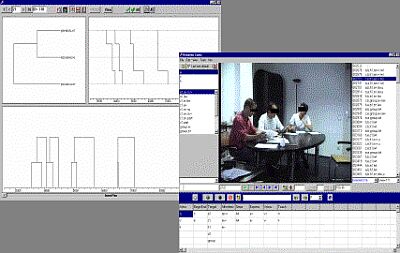
Detecting interaction patterns in task-oriented small groups:
video analysis in social sciences research
J. Zumbach1, S.C. Koch1 and G.K. Jonsson2
1University of Heidelberg, Heidelberg, Germany
2HBL, University of Iceland, Reykjavik, Iceland
The aim of our research is to search for communicative patterns in task-oriented small groups from videotaped interaction sequences, using the software Theme [2]. This software has been developed to detect and analyze particular types of repeated syntactical real-time patterns based on probability theory, regardless of the type of behavioral unit or time scale used.
In Study One, an instructional psychology project with a cognitive science background, we analyzed collaborative knowledge construction processes within a Problem-Based Learning (PBL) session [3,4]. In this study, we found that interaction patterns in a learning group would change in quality and quantity, both before and after a training phase. For example, participants displayed more complex interaction patterns in the final discussion, after an individual learning phase, than at the beginning. This change of pattern was comprehensively visualized by the Theme output graphics (Figure 1).

Figure 1. Example of an analysis of visual dominance behavior and other non-verbal dominance cues in the context of a training team meeting. Left: THEME graphics output of a t-pattern. Right: Multimedia behavior coder and categories.
In Study Two, an interdisciplinary project involving psychologists and linguists, we analyzed observed gender interaction and gender construction processes at the workplace in same-sex and mixed-sex team conversation [1]. The focus was on power-related and support-related behavior, as well as on behavioral quality and verbal/non-verbal patterns. A turn- and sequence-based coding scheme was developed to analyze data from 20 teams, which were audio-visually taped during two or three of their routine team meetings. Using Theme, we were able to find specific interaction patterns that would not otherwise have been easy to detect.
The use of Theme in these two different contexts, and its potential for wider research within the social sciences, will be discussed.
We thank the German Science Foundation (DFG) for their financial support of this research.
References
Paper presented at Measuring Behavior 2002 , 4th International Conference on Methods and Techniques in Behavioral Research, 27-30 August 2002, Amsterdam, The Netherlands